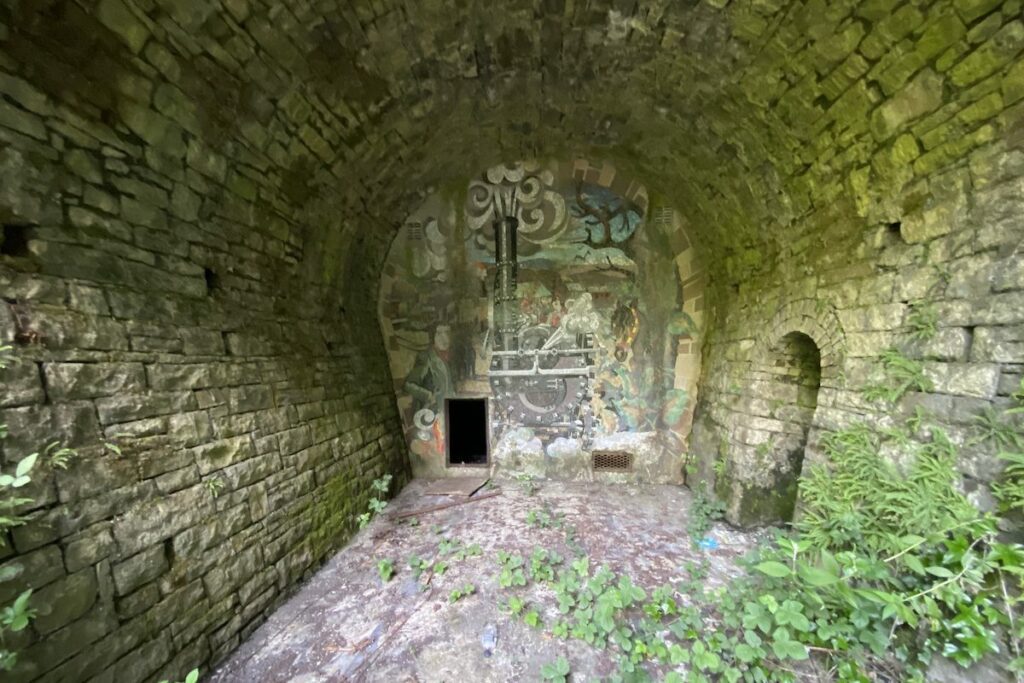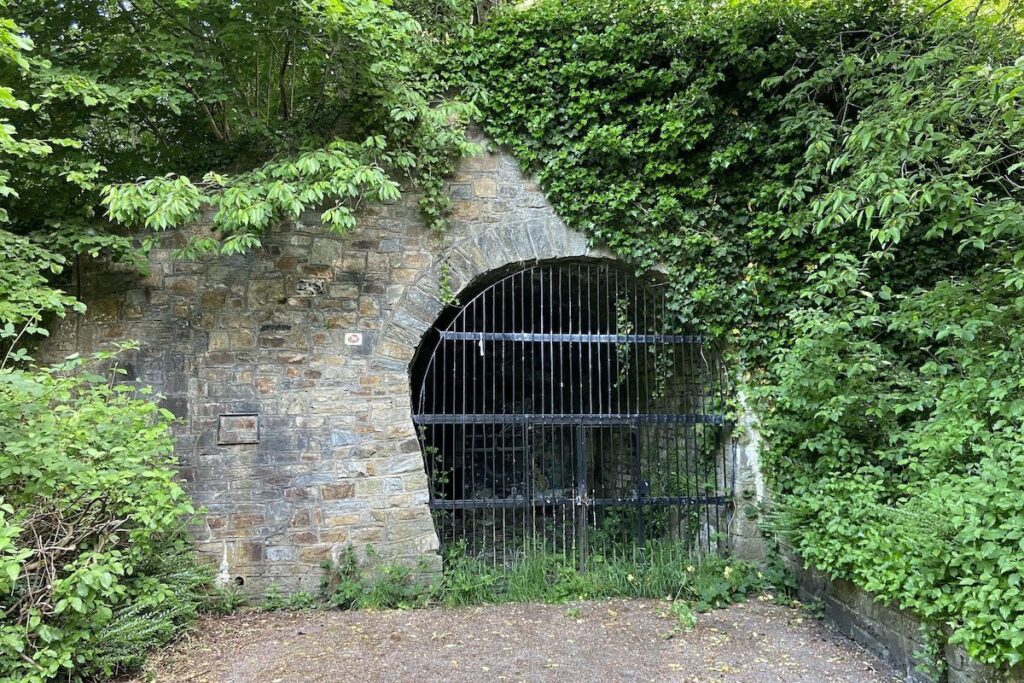Trevithick Tunnel
Trevithick Tunnel is an early railway tunnel that carried the Merthyr Tramroad, which was used to run the world’s first journey by steam locomotive. The tunnel is sealed, and the south portal is only visible. It is a Scheduled Monument and of national importance for its potential to enhance and illustrate our understanding the origins of the world’s first railway network.

Key info
| Location | A4054, Merthyr Tydfil, CF48 1YB |
| County | Merthyr Tydfil County Borough |
| Completed | 1802 |
| Engineer | George Overton |
| Heritage category | Scheduled Monument |
Visiting guide
Open 24 / 7
Free entry
Free car park
What can I expect when visiting Trevithick Tunnel?
Trevithick Tunnel lies on National Cycle Route 8, informally known as the ‘Trevithick Trail’. You can start your visit to the tunnel at the beginning of the trail; however, this guide will start from the car park. You will see a path that leads up to the tunnel.

Follow the path up to the tunnel. There is also an information board.

Peek through the metal bars for a view of the mosaic depicting the first journey by steam locomotive in 1804. A Cornish engineer called Richard Trevithick created the world’s first steam locomotive at the Pen-y-Darren Ironworks. The maiden journey ran on the Merthyr Tramroad, a freight railway that delivered raw materials via horse drawn waggons. The tramroad ran through this very tunnel, which carried it under the blast furnaces of the Plymouth Ironworks that existed further up the trail. Notice the refuge arch on the right that would have been used by workers to avoid oncoming traffic.

We recommend you now follow the Trevithick Trail south and discover more of the history behind the Merthyr Tramroad and the first journey on rails by steam locomotive. and continue to our starting position.
How long does it take to visit Trevithick Tunnel?
It will take you about 10 minutes to walk up to the tunnel from the car park and back; therefore, you may wish to extend your visit by walking south along the Trevithick Trail, which follows much of the original Merthyr Tramroad route. It leads you down the Taff Valley to Abercynon.
Is Trevithick Tunnel suitable for a picnic?
No, because there is little open space despite the tunnel being located in a green area.
How do I get to Trevithick Tunnel?
There is a car park a few minutes’ walk south from the tunnel. Merthyr Tydfil railway station is under a mile away and net to the A4054 with bus services to and from the town.
History of Trevithick Tunnel
1799 – An Act of Parliament is submitted for permission to build a tramroad connecting the Dowlais, Pen-y-Darren, and Plymouth Ironworks in Merthyr Tydfil 10 miles south to Abercynon. The requirement of a tramroad arose after multiple quarrels between the ironworks above with the neighbouring Cyfarthfa Ironworks and its influence on the charges for using the Glamorganshire Canal at Merthyr.
1802 – The Merthyr Tramroad is complete and begins operations transporting ironstone, limestone, and pig iron. The route passed under the blast furnaces of the Plymouth Ironworks via a tunnel that is now called Trevithick Tunnel.
1804 – A Cornish engineer called Richard Trevithick had arrived in Merthyr Tyfil to install multiple high-pressure stationary steam engines for Samuel Homfray, the owner of the Pen-y-Darren Ironworks. Trevithick had obtained a patent for his high-pressured steam engine design in 1802 and was determined to demonstrate their advantages, especially as moving locomotives. Homfray was also confident about the commercial benefits of this radical new technology. He wagered 500 guineas (approximately £29,750 in 2023) with the ironmaster of the Cyfarthfa Ironworks that Trevithick could run a steam locomotive hauling ten tonnes of iron down the Merthyr Tramroad from Pen-y-Darren to Abercynon. On 21st February, Trevithick made history by running the first ever journey on rails powered by steam traction. He hauled ten tonnes of iron and 70 men 9 miles down the Merthyr Tramroad at 5 mph however the heavy engine broke many cast iron tram plates on which it ran [1]. Trevithick’s journey passed through what is now called Trevithick Tunnel. To achieve this, the existing double line of tram plates was removed from the tunnel and replaced by a single line below the centre of the arch [2].
1830 – The tunnel is extended to the south [2].
1880 – The Plymouth Ironworks closes after years of declining trade [3]. It is most likely that use of the Merthyr Tramroad through Trevithick Tunnel would have ceased shortly after.
2007 – Trevithick Tunnel is first designated as a Scheduled Monument [2].
Dimensions
The original tunnel constructed in 1802 measures about 110 m in length, 2.44 m in height and 2.57 m in width. The extension constructed in 1830 measures about 70m in length, 3.96m in height and 3.96m in width [2].
Sources
- Rattenbury G. and Lewis M. J. T. (2004) Merthyr Tydfil Tramroads and their Locomotives. Oxford: Railway & Canal Historical Society.
- Cadw (2020) Scheduled Monuments- Full Report. Available at: https://cadwpublic-api.azurewebsites.net/reports/sam/FullReport?lang=&id=4048 (Accessed: 18 June 2023).
- Hayman, R. (1989) Working Iron in Merthyr Tydfil. Merthyr Tydfil: Merthyr Tydfil Heritage Trust.

 Coalport Bridge
Coalport Bridge